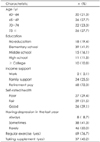1. Dwyer J. Frankler RT, Owen AL, editors. The elderly. handbook of Nutrition in the community. 1993. Mosby-Year Book;230–235.
2. Kim SK, Kang HK, Kim JH. Socio-economic factors affecting the health and nutritional status of the aged. Korean J Nutr. 2000. 33(1):86–101.
3. Yang EJ, Kim WY. New paradigm for Dietary reference intakes: American/Canadian dietary reference intakes (DRIs): Elderly. Korean J Nutr. 2004. 37(7):603–605.
4. Krunbolz HM. Lack of association between cholesterol and coronary heart disease mortality and morbidity and all-cause mortality in persons older that 70 years. JAMA. 1994. 272:1335–1342.

5. Park MY, Lee KH, Youn HS. Nutrition status of the rural elderly living in Kyungnam. Korean J Community Nutrition. 2001. 6:3S. 527–541.
6. Pakr JK, Son SM. The dietary behaviors, depression rates and nutrient intakes of the elderly females living alone. Korean J Community Nutrition. 2003. 8(5):716–725.
7. Kim YK, Lee HO, Chang L, Choue RW. A study on the food habits, nutrient intake and the disease distribution in the elderly (aged over 65 years)(I). Korean J Community Nutrition. 2002. 7(4):516–526.
8. Posner BM, Jette AM, Smith KW, Miller DR. Nutrition and health risk in the elderly: the Nutrition Screening Initiative. Am J Public Health. 1993. 83:972–978.

9. Vellas B, Guigoz Y, Garry PJ, Albarede JL. The mini Nutritional Assessment (MNA) and its use in grading the nutritional state of elderly patients. Nutrition. 1999. 15:116–122.

10. Bouillanne O, Morieneau G, Dupont C, Aussel C. Geriatric Nutritional Risk Index: a new index for evaluating at-risk elderly medical patients. Am J Clin Nutr. 2005. 82:777–783.

11. Bonnefoy M, Ayzac L, Ingenbleek Y, Bienvenu J. Usefulness of the prognostic inflammatory and nutritional index (PINI) in hospitalized elderly patients. Intern J Vitamin and Nutrition Research. 1998. 68(3):189–195.
12. Naber T, Bree A, Schermer T, Bakkeren J, Bar Brigit, Wild G, Katan MB. Specificity of indexes of malnutrition when applied to apparently healthy people: the effect of age. Am J Clin Nutr. 1997. 65:1721–1725.

13. Pablo R, Izaga A, Alday A. Assessment of nutritional status on hospital admission: Nutritional scores. Eur J Clin Nutr. 2003. 57(7):824–831.

14. Kondrup J, Allison SP, Elia M, Vella B, Plauth M. ESPEN guidelines for Nutrition Scerrning 2002. Clin Nutr. 2003. 22(4):415–421.
15. Han KH, Choi M, Park J. Nutritional risk and its related factors evaluated by the mini nutritional assessment for the elderly who are meal service participants. Korean J Nutr. 2004. 37(8):675–687.
16. Yoon JS, Lee JH. Nutrient intake, zinc status and health risk factors in elderly Korean women as evaluated by the nutrient screening initiative (NSI) checklist. Korean J Community Nutrition. 2002. 7(4):539–547.
17. Lee KW, Lee YM, Kim JH. The health and nutritional status of low-income, alone living elderly. Korean J Community Nutrition. 2000. 5(1):3–12.
18. Lee JW, Kim KE, Kim KN, Hyun TS, Park YS. Evaluation of the validity of a simple screening test developed for identifying Korean elderly at risk of undernutrition. Korean J Nutr. 2000. 33(8):864–872.
19. Omran ML, Morley JE. Assessment of protein energy malnutrition in older persons, part I: History, Examination, body composition, and screening tools. Nutrition. 2000. 16:50–63.

20. Omran ML, Morley JE. Assessment of protein energy malnutrition in older persons, part II: Laboratory evaluation. Nutrition. 2000. 16:131–140.

21. The Korean Nutrition Society. Dietary reference intakes for Koreans. 2005.
22. Green Cross Research Lab. Clinical Research Service. 2007.
23. Caterina R, Zampolli A, Turco SD, Madonna R, Massaro M. Nutritional mechanism that influence cardiovascular disease. Am J Clin Nutr. 2006. 83:suppl. 421S–426S.
24. Yang EJ, Bang HM. Nutritional status and health risks of low income elderly women in Gwangju area. Korean J Nutr. 2008. 413(4):65–76.
25. Ministry of Health and Welfare. 2005 National Health and Nutrition Survey: Overview. 2007.
26. Yang EJ, Kim WY. Nutritional Status of Korean Elderly. Korean J Gerontol. 2005. 15(1):1–10.
27. Park JK, Son SM. Anthropometric and biochemical indicators and related factors for the community dwelling elderly living alone. Korean J Community Nutrition. 2003. 8(5):726–735.
28. Kagansky N, Berner Y, Koren-Morag N, Perelman L, Knobler H, Levy S. Poor nutritional habits are predictors of poor outcome in very old hospitalize patients. Am J Clin Nutr. 2005. 82:784–791.










 PDF
PDF ePub
ePub Citation
Citation Print
Print






 XML Download
XML Download